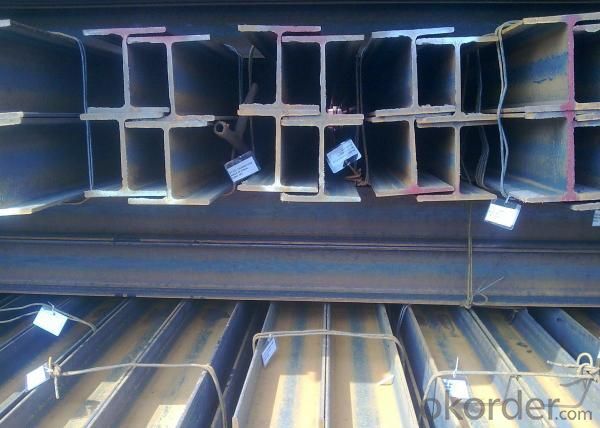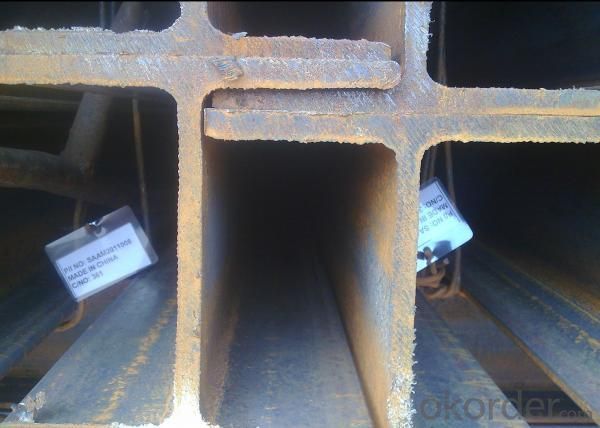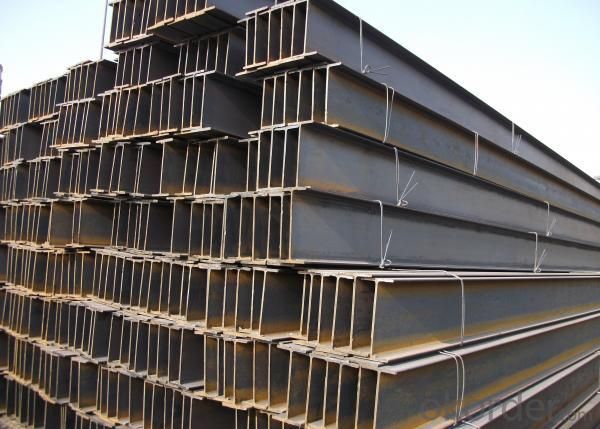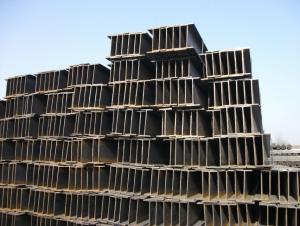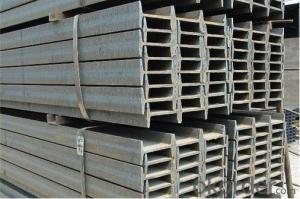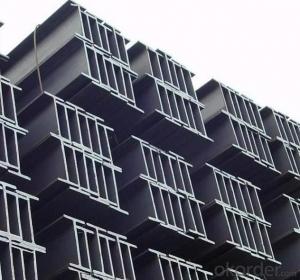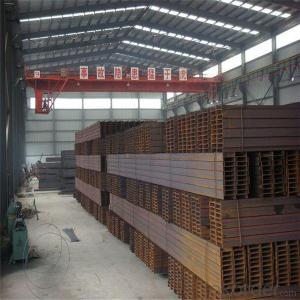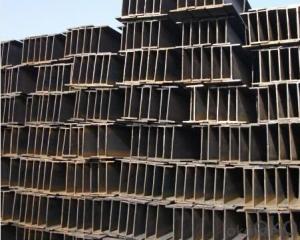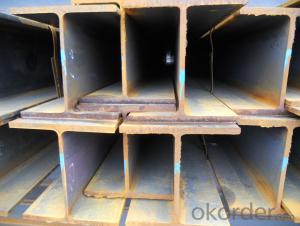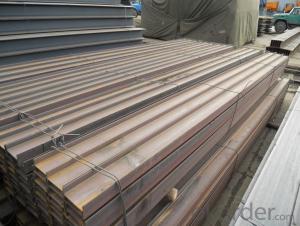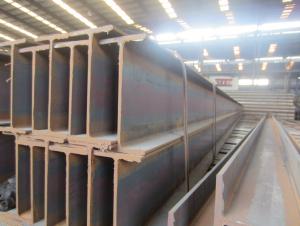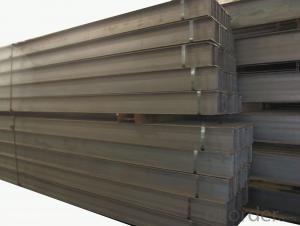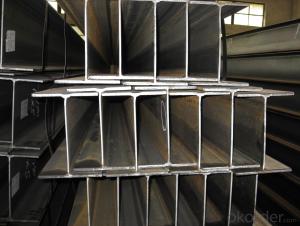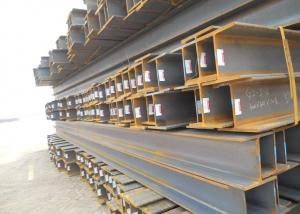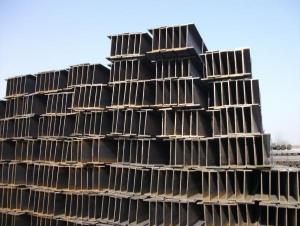Hot Rolled Alloy Constructural Steel H Beam
- Loading Port:
- China Main Port
- Payment Terms:
- TT or LC
- Min Order Qty:
- 100MT m.t.
- Supply Capability:
- 10000MT/month m.t./month
OKorder Service Pledge
OKorder Financial Service
You Might Also Like
Specifications of Hot Rolled Alloy Constructural Steel H Beam
1. Standard: HEA100-HEA500,HEB100-HEB500
2. Grade: Q235, SS400 or Equivalent
3. Length: 6m,10m, 12m as following table
4. Invoicing on theoretical weight or actual weight as customer request
5.Payment: TT or L/C
6. Sizes:
SIZE(mm) | DIMENSION(kg/m) |
100*100 | 16.9 |
125*125 | 23.6 |
150*75 | 14 |
150*150 | 31.1 |
148*100 | 20.7 |
198*99 | 17.8 |
200*100 | 20.9 |
248*124 | 25.1 |
250*125 | 29 |
300*150 | 36.7 |
298*149 | 32 |
200*200 | 49.9 |
294*200 | 55.8 |
346*174 | 41.2 |
350*175 | 49.4 |
244*175 | 43.6 |
175*175 | 40.4 |
294*200 | 55.8 |
298*201 | 64.4 |
346*174 | 41.2 |
350*175 | 49.4 |
400*200 | 65.4 |
396*199 | 56.1 |
450*200 | 74.9 |
446*199 | 65.1 |
340*250 | 78.1 |
500*200 | 88.1 |
300*150 | 36.7 |
Usage & Applications of Hot Rolled Alloy Constructural Steel H Beam
Commercial building structure ;Pre-engineered buildings; Machinery support structure; Prefabricated structure; Medium scale bridges; Ship-building structure. etc.
Packaging & Delivery of Hot Rolled Alloy Constructural Steel H Beam
1. Packing: it is nude packed in bundles by steel wire rod
2. Bundle weight: not more than 3.5MT for bulk vessel; less than 3 MT for container load
3. Marks:
Color marking: There will be color marking on both end of the bundle for the cargo delivered by bulk vessel. That makes it easily to distinguish at the destination port.
Tag mark: there will be tag mark tied up on the bundles. The information usually including supplier logo and name, product name, made in China, shipping marks and other information request by the customer.
If loading by container the marking is not needed, but we will prepare it as customer request.
4. Transportation: the goods are delivered by truck from mill to loading port, the maximum quantity can be loaded is around 40MTs by each truck. If the order quantity cannot reach the full truck loaded, the transportation cost per ton will be little higher than full load.
5. Delivered by container or bulk vessel
Production flow of Hot Rolled Alloy Constructural Steel H Beam
Material prepare (billet) —heat up—rough rolling—precision rolling—cooling—packing—storage and transportation
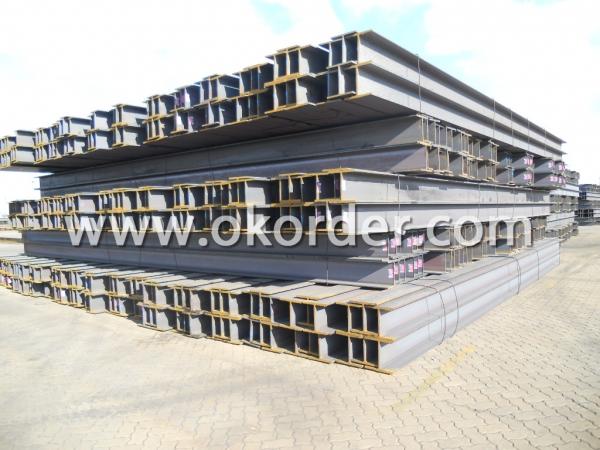
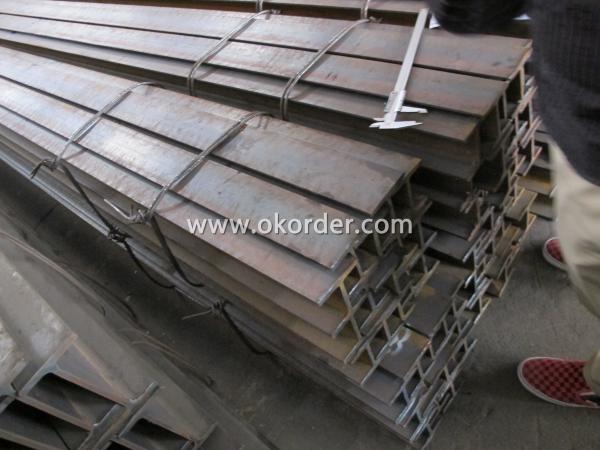
- Q: What are the common inspection methods for steel H-beams?
- The common inspection methods for steel H-beams involve both visual and non-destructive testing techniques. Visual inspection is the initial step in the inspection process, where the surface of the H-beams is examined for any visible defects such as cracks, surface irregularities, or signs of corrosion. Non-destructive testing (NDT) methods are then employed to assess the internal quality of the steel H-beams without causing any damage. These techniques include: 1. Ultrasonic Testing (UT): UT uses high-frequency sound waves to detect internal flaws or defects in the steel H-beams. It is effective in identifying cracks, voids, and inclusions that may compromise the structural integrity of the beams. 2. Magnetic Particle Testing (MT): MT utilizes the principle of magnetic field attraction to identify surface or near-surface defects in the steel H-beams. A magnetic field is applied to the beams, and iron particles are applied on the surface. Any magnetic leakage caused by defects will attract the iron particles, making the defects visible. 3. Dye Penetrant Testing (PT): PT involves the application of a colored liquid dye on the surface of the steel H-beams. The dye penetrates into any surface cracks or defects, and after a specific time, excess dye is removed. A developer is then applied, which draws out the dye from the defects, making them visible for inspection. 4. Radiographic Testing (RT): RT uses X-rays or gamma rays to inspect the internal structure of the steel H-beams. The beams are exposed to radiation, and the resulting image is captured on a film or digital detector. This allows for the detection of internal flaws such as cracks, porosity, or inclusions. These inspection methods are commonly used to ensure the quality and integrity of steel H-beams in various industries, including construction, manufacturing, and infrastructure projects. The combination of visual inspection and NDT techniques provides a comprehensive assessment of the H-beams' condition and helps identify any potential issues before they lead to structural failures.
- Q: What are the different surface finishes available for steel H-beams?
- Some common surface finishes available for steel H-beams include black oxide, galvanized, painted, and powder coated. These finishes serve different purposes such as enhancing corrosion resistance, improving aesthetics, or providing a protective coating.
- Q: How are steel H-beams manufactured?
- Steel H-beams are manufactured through a process known as hot rolling. This involves heating a large billet of steel to a high temperature and then passing it through a series of rollers to shape it into the desired H-beam profile. The first step in the manufacturing process is the preparation of the raw materials. High-quality steel is selected, usually in the form of a large billet, which is a semi-finished long product. The billet is then heated in a furnace to a temperature above its recrystallization point, typically around 1200 to 1300 degrees Celsius. Once the billet reaches the desired temperature, it is fed into a rolling mill. The mill consists of a series of rollers that gradually shape the heated billet into the H-beam profile. The rollers apply pressure to the billet, causing it to elongate and take on the desired shape. This process is known as hot rolling because the steel is rolled while it is still hot and malleable. During the rolling process, the billet is continuously passed through the rollers, undergoing multiple passes until it achieves the required dimensions and shape. The shape of the rollers determines the final profile of the H-beam, with each roller gradually shaping the steel into the desired form. After the rolling process is completed, the newly formed H-beams are cooled either by air or water. This cooling process is essential for the steel to retain its strength and structural integrity. Once cooled, the H-beams are cut to the desired lengths and undergo any necessary further processing, such as surface treatment or galvanization, before being packaged and shipped to customers. Overall, the manufacturing of steel H-beams involves the heating of a billet to a high temperature, hot rolling it through a series of rollers to shape it into the desired profile, and then cooling and further processing the finished beams. This process ensures the production of high-quality and structurally sound H-beams that are widely used in various construction and engineering applications.
- Q: What is the weight per meter of steel H-beams?
- The weight of steel H-beams per meter can differ based on their size and specifications. Typically, the weight of these beams is determined by multiplying the density of steel, approximately 7850 kilograms per cubic meter, by the cross-sectional area of the beam. To calculate the weight per meter, one must have knowledge of the H-beam's dimensions, including its height, width, and flange thickness. By utilizing these measurements to determine the cross-sectional area, one can then multiply it by the density of steel to obtain the weight per meter. For instance, let's consider an H-beam with a height of 200 millimeters, a width of 100 millimeters, and a flange thickness of 10 millimeters. The cross-sectional area for this beam would be (200 * 100) + 2 * (10 * 100), resulting in 22,000 square millimeters or 0.022 square meters. Assuming a density of steel at 7850 kilograms per cubic meter, the weight per meter for this H-beam would be 0.022 * 7850 = 173 kilograms per meter. It's crucial to note that this calculation is provided as an example, and the weight per meter can vary based on the specific dimensions and specifications of the steel H-beams.
- Q: Can steel H-beams be used in automotive manufacturing?
- Yes, steel H-beams can be used in automotive manufacturing. They are commonly used in the construction of vehicle frames and chassis due to their high strength-to-weight ratio and structural stability.
- Q: I would like to ask you to do the master of steel structure, steel H steel cost per ton, how many yuan? emergency
- The H steel is priced at 850-1100 tons, with two rustproof primers and two alkyd finishesInstallation of steel structure costs between 350-450 tons per ton.I do steel structure budget, do not understand, you can ask me!
- Q: Can steel H-beams be used for supporting industrial silos or storage tanks?
- Yes, steel H-beams can be used for supporting industrial silos or storage tanks. The H-beams provide excellent structural support and stability, making them a suitable choice for such applications. The high strength and load-bearing capacity of steel H-beams make them capable of withstanding the weight and pressure exerted by silos or storage tanks, ensuring the overall integrity and safety of the structure.
- Q: What are the disadvantages of using steel H-beams?
- There exist multiple drawbacks associated with the utilization of steel H-beams in construction endeavors. To begin with, steel H-beams possess a relatively heavy weight in comparison to other construction materials. This characteristic can present challenges during transportation and installation, particularly in projects that necessitate large quantities of beams. Furthermore, the weight of steel H-beams contributes to the overall load-bearing capacity of the structure, potentially requiring additional reinforcement or support. In addition, if not adequately protected, steel H-beams are susceptible to corrosion. Exposure to moisture and harsh weather conditions can lead to rust and structural deterioration over time. To prevent corrosion, extra measures such as galvanization or regular maintenance become necessary, which increase the overall cost and effort involved. Furthermore, when juxtaposed with certain alternative materials, steel H-beams do not possess the same level of environmental friendliness. The production of steel demands significant energy consumption and results in substantial carbon dioxide emissions, thereby contributing to climate change. Moreover, steel is not a renewable resource and necessitates mining and extraction, processes that can have detrimental effects on the environment. Lastly, steel H-beams offer limited design flexibility when compared to alternative materials. The standard shape and size of H-beams may not always align with specific architectural or structural designs. This limitation can curtail the creativity and customization options available to architects and engineers, potentially compromising the overall aesthetics or functionality of the project. In summary, while steel H-beams boast numerous advantages such as high strength and durability, it is essential to consider these disadvantages, including weight, corrosion, environmental impact, and design limitations, when making a decision regarding their usage in a construction project.
- Q: What are the different methods of installing steel H-beams?
- Installing steel H-beams can be done using various methods, depending on the project requirements and available resources. Below are some commonly used techniques: 1. The first method involves the use of heavy machinery like cranes or forklifts to lift and position the steel H-beams. This approach is typically employed for larger structures or when installing beams at significant heights. 2. Welding is another common technique used to connect steel H-beams either to each other or to other structural elements. It requires melting and fusing the metal to create a strong joint. Welding can be carried out on-site or in a fabrication shop, depending on the project's needs. 3. Bolting is a method where bolts and nuts are used to secure the steel H-beams together or to other structural components. Bolting is often favored in situations where future disassembly or modifications may be necessary. 4. Concrete embedment is employed when additional stability and support are required. Steel H-beams are embedded in concrete by creating holes in the concrete structure and placing the beams into them. The beams are then held in place as the concrete sets. 5. Steel plates and brackets can also be utilized to connect steel H-beams to other structural elements. These plates are typically attached to the beams through bolting or welding and then affixed to the desired location. It is crucial to consider factors such as project requirements, structural design, and available resources when choosing the appropriate method for installing steel H-beams. Seeking advice from a structural engineer or construction professional is highly recommended for determining the most suitable installation approach for a specific project.
- Q: How do steel H-beams perform in areas with high wind loads?
- Steel H-beams perform very well in areas with high wind loads. The H-shape design of these beams provides superior strength and stability, making them highly resistant to lateral forces caused by strong winds. The structural integrity of steel H-beams allows them to distribute the wind load evenly throughout the entire beam, minimizing the risk of failure or deformation. Additionally, steel is a durable and flexible material, which further enhances its performance in high wind areas. The high tensile strength of steel enables it to withstand the pressure exerted by strong winds, offering excellent resistance against bending or buckling. Overall, steel H-beams are an ideal choice for construction in areas with high wind loads, providing reliable and long-lasting support to structures in such conditions.
1. Manufacturer Overview
| Location | Tangshan, China |
| Year Established | 2009 |
| Annual Output Value | Above US$ 230 Million |
| Main Markets | Mid East; Southeast Asia; Korea |
| Company Certifications | ISO 9001:2008; |
2. Manufacturer Certificates
| a) Certification Name | |
| Range | |
| Reference | |
| Validity Period |
3. Manufacturer Capability
| a) Trade Capacity | |
| Nearest Port | Tianjin; |
| Export Percentage | 81% - 90% |
| No.of Employees in Trade Department | 21-50 People |
| Language Spoken: | English; Chinese; |
| b) Factory Information | |
| Factory Size: | Above 500,000 square meters |
| No. of Production Lines | 1 |
| Contract Manufacturing | OEM Service Offered; |
| Product Price Range | Average |
Send your message to us
Hot Rolled Alloy Constructural Steel H Beam
- Loading Port:
- China Main Port
- Payment Terms:
- TT or LC
- Min Order Qty:
- 100MT m.t.
- Supply Capability:
- 10000MT/month m.t./month
OKorder Service Pledge
OKorder Financial Service
Similar products
Hot products
Hot Searches
Related keywords




